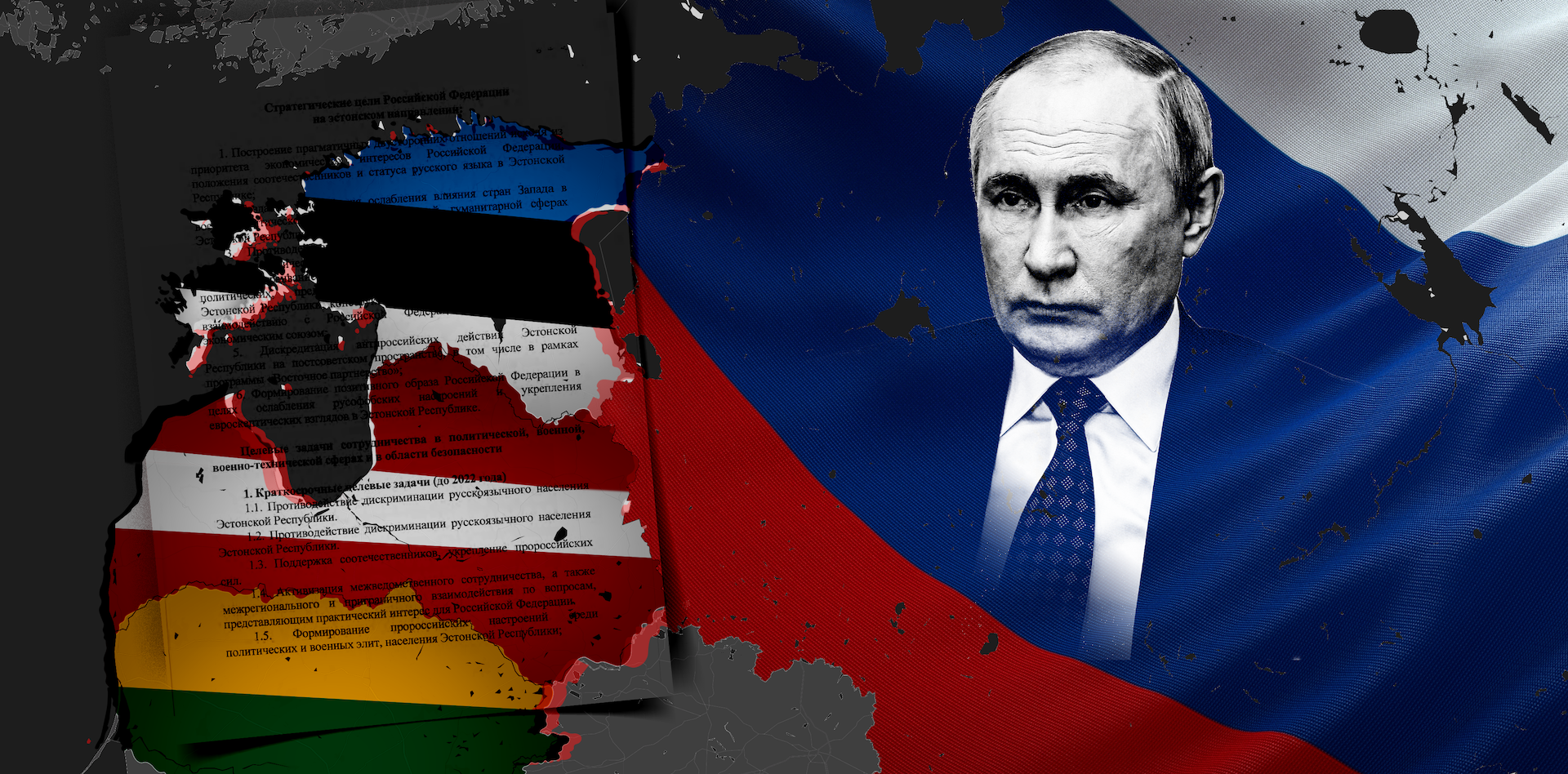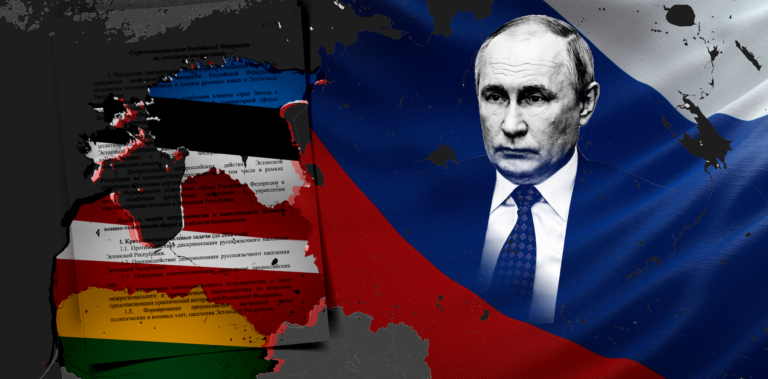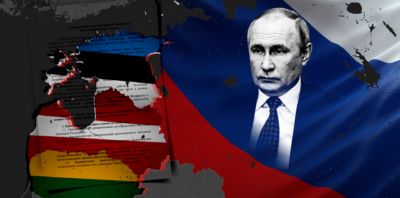Illustration: Karl-Erik Leik (Delfi Estonia) 2023-04-25
Illustration: Karl-Erik Leik (Delfi Estonia) 2023-04-25
VSquare is in possession of files compiled by the Kremlin that reveal Russia’s plans to exert influence in Estonia, Latvia, and Lithuania now and in the coming years.
Two separate documents have been prepared for each of the Baltic countries, the first of which lists the “strategic interests of the Russian Federation” by sector and timeline, and the second of which also outlines the risks that lie for Russia.
These plans were drawn up in summer and autumn of 2021 by the Russian Presidential Administration—specifically, in the Directorate for Cross-Border Cooperation. This is a body staffed by people with backgrounds in Russia’s various intelligence agencies. Its actual purpose is not to promote cross-border cooperation but to develop plans to keep or bring to power political forces in Russia’s so-called western neighborhood, to exert Kremlin influence, to “protect” Russian language and educational rights, and to undermine pro-Western and pro-NATO sentiment.
For example, the first major objective of the document on Estonia is to “Build pragmatic bilateral relations based on the priority of the economic interests of the Russian Federation, the position of compatriots, and the status of the Russian language in the Republic of Estonia.” The next is the creation of conditions “for weakening the influence of Western countries in the military-political, trade-economic, humanitarian spheres of the Republic of Estonia.” And two other general objectives concern discrediting Estonia’s anti-Russian activities in the post-Soviet space—especially in the framework of the Eastern Partnership programme—and forming a positive image of the Russian Federation in order to weaken Russophobic sentiments and strengthen Euroscepticism.
“Naturally, we have to pay serious attention to such plans,” Aleksander Toots, deputy director general of the Estonian Internal Security Service known by its acronym KAPO, said when VSquare showed him the documents. “But we also need to understand which point in time the documents originate from. We can’t only make assessments based on such documents because sometimes they can be intentionally misleading regarding the seriousness of Russia’s real desires.
“This means that we also need to assess the signs on the ground – are there signs that they are trying to enforce such plans. Or maybe the set strategic goals have already become obsolete because of changed circumstances. If you see that the plans are being implemented, you need to do everything you can to put brakes on it,” Toots said
VSquare obtained the documents together with journalists from Delfi Estonia, the Swedish newspaper Expressen, the Dossier Center, investigative journalism center Re:Baltica (Latvia), the Lithuanian national broadcaster, Frontstory (Poland), the American Yahoo News, the German newspaper Süddeutsche Zeitung and broadcasting networks WDR and NRD, and the Kyiv Independent (Ukraine). They are part of the same series as the documents we revealed in February and March on Russia’s plan to swallow up Belarus and to turn Moldova back on its pro-Russian path.
Shaping public opinion
The strategic objectives are divided into three chapters, according to the blueprint from Vladimir Putin’s decree creating the Directorate for Cross-Border Cooperation: first, political, military, military-technical and security related objectives; then trade and economic; and thirdly, humanitarian or society-related goals. All chapters are divided into three time frames: short term (by year 2022), medium term (2025) and long term (2030).
Short-term policy goals include creating pro-Russian sentiment in Estonian society and among the political and military elites; limiting the influence of nationalist forces; and creating new public associations and non-governmental organizations that promote cooperation with Russia.
While the strategy document does not specifically spell out how Russia was to achieve specific goals, one doesn’t need to look far to see attempts to bolster pro-Russian sentiment and create political pressure. For example, in parliamentary elections held in Estonia this March, the leader of a newly-formed pro-Moscow political movement TOGETHER/Vmeste, Aivo Peterson, narrowly missed out from winning a seat. The TOGETHER movement as a whole did so well that it was eligible for state funding for the next four years.
Peterson received support from Russia, appearing in both occupied Donbass and Mariupol in South-Eastern Ukraine just before the elections. On election day he appeared on the notorious propagandist Vladimir Solovyov’s TV show on Russian state TV.
Although Peterson is currently detained in Estonia on suspicion of knowingly cooperating with a foreign country’s intelligence services, his election results prove that such pro-Russian views can be attractive in the predominantly Russian-speaking areas in the North-Eastern parts of Estonia. And, at the same time, one of the aims listed in the Estonian strategy document is to counteract Estonia’s efforts to “foster separatist sentiments in the Russian regions [and] to create such sentiments among representatives of Finno-Ugric peoples living in Russia.”
Among Russia’s medium-term goals is the shaping of public opinion against NATO’s military presence in Estonia, as well as “the creation of stable pro-Russian influence groups in Estonia’s political, military and business elites.”
Attempts to cultivate anti-NATO sentiment in the Baltic countries are also evident. For example, Russian propaganda channels and Russian-language groups on the Telegram social networking site are vigorously amplifying everything about the expansion of the Nursipalu and Soodla military training fields.
Just last week, the locally well-known Russian propaganda site Baltija published a “debate video” in which three representatives of the TOGETHER movement, Julia Smoli, Igor Hopp and Sandra Sirge, tell horror stories about the expansion of the training fields.
“The exercises will take place in such a way, that the HIMARSes will be flying from Nursipalu to Soodla and back. I hope that none of the HIMARS will land in the wrong place, but anything is possible,” says Smoli. The two training fields are actually on the opposite sides of Estonia and 130 miles apart. They are not planned for shooting HIMARS rockets from one to another. Then Smoli adds: “2023 will be, it seems to me, the last year of independence. And I feel very painful about it.”
She also claims that according to local people, “tactical weapons will be developed there [in Soodla]. That means heavy metals, there are a lot of lakes. Lake Ülemiste [that provides the capital Tallinn with drinking water] gets 60% of its water from Soodla. Do you understand what we are going to drink? And what diseases we are going to get?’ (these claims are totally unsubstantiated).
The “debate,” resulted in the conclusion that there is no real need for polygons because Russia has no military interest in Estonia. “All this military rhetoric around the Nursipalu and Soodla polygons only brings us closer to military tension in Estonia itself. […] 20 minutes from Tallinn, a military polygon will be opened, where NATO forces will also come,” says Sirge. “I don’t want to see war from my window.”
The Russian bluff
In the longer term, the Kremlin set the goals of “restoring relations between the Russian Federation and the Republic of Estonia” “supporting the emergence of politicians who want to develop Estonian-Russian relations,” achieving “non-discrimination of the Russian-speaking population in Estonia” and supporting pro-Russian influence groups and making them more effective. It wanted all of this accomplished by 2030.
One of the most interesting—and, to some extent at least, most outdated—chapters involves how Russia plans to influence the Baltic countries through the economy, trade and business. Their immediate aim was to increase Russian exports and bilateral trade with the three countries and also to attract direct investment to Russia’s border regions and in areas of interest to Russia, such as oil shale chemistry and green energy.
One European intelligence official, who is well aware of the origin and background of the documents, said that it was very unlikely that their authors were aware of the forthcoming full-scale invasion of Ukraine. The Russian-language BBC has reported that Dmitry Kozak, vice-president of Vladimir Putin’s administration, to whom the Directorate for Cross-Border Cooperation reports directly, opposed the war in Ukraine and has therefore since lost Putin’s favor. “It is likely that the change in the situation due to the war has forced the Kremlin to reconsider and change some of these plans concerning the Baltic states,” the intelligence source said.
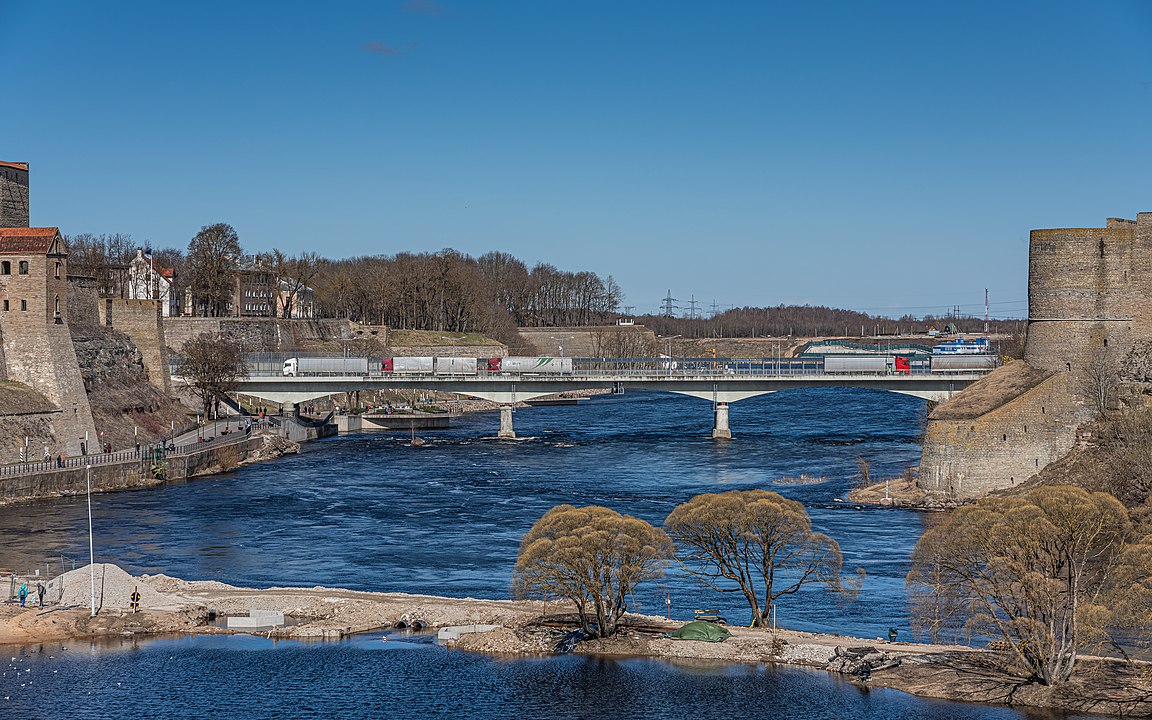
Narva-Ivangorod bridge, 2022. Source: A.Savin / Wikimedia Commons
Aleksander Toots also said that the people who drafted the documents probably had no idea that reality would soon take a completely different turn. “For example, they aim to increase exports to Estonia by 2022, but last summer Russia itself decided to close the Narva-Ivangorod bridge to trucks [in retaliation for Estonia’s support for Ukraine]. How can you increase exports if you close the main channel?”
The documents specifically envisage influencing Estonian, Latvian and Lithuanian states policies through entrepreneurs. “Work with Estonian businessmen to explain the Russian Federation’s readiness to open up the Russian market to them, provided that Tallinn adjusts to being more pro-Moscow in its foreign policy,” reads one such section. And in another: the stated goal of creating sustainable pro-Russian influence groups among Estonia’s economic elite.
“Entrepreneurs are the most easily vulnerable and influenceable group. Once a politician runs out of votes and power, he has nothing. But as long as businessmen have money, they will try to influence [politics] in their own interests,” Toots commented. He recalled that Russia has been using the same tactics for a long time, both in Ukraine and in the so-called People’s Republics of Lugansk and Donetsk.
The Latvian foreign and counter-intelligence service, the Constitution Protection Bureau (SAB), stated in written comments that coordinated propaganda and influence operations by intelligence and security agencies play a significant role in Russia’s pursuit of such objectives. “This includes obtaining intelligence information and conducting research on the possibilities of influence, working with agents of influence, including providing financing to various individuals and groups in Europe to use as a lobby for Russian interests. The Kremlin’s interest lobby is often carried out through economic interests and businessmen whose activities are related to Russia.”
“As a strategic plan these documents are very shrewd. If you want to outplay your opponent, tie them with you: economically, trade-wise, culturally,” Toots said.
However, Toots pointed out that the documents also contain some fiction and fantasy that was never going to come true, and the Russian authors were probably well aware of that. He pointed to the objectives of so-called militarisation and NATO’s presence in the Baltic countries. “Militarization is a mirror-behavior. If your neighbor on the other side of the border is building its military presence, it is obvious that you will do the same. So if Russia would really want there to be less military presence in Estonia, it should stop the aggression and aggressiveness.”
Toots also said that the plans exude something he referred to as the Russian bluff. “Knowing how the Russian regime operates, I can say that the employees there have a habit of lying to their bosses because the bosses don’t like to receive unvarnished accounts of the real situation. If you provide them with embellished stories, you will live in an illusion. The Russian system is built on everyone bluffing. Those few who try to convey the real picture are mentally eaten out by the system.”
According to Marius Laurinavičius, a Lithuanian expert on international affairs, the Kremlin’s plans for the Baltics reflect time-tested Soviet tactics. “This is the old KGB method: ‘We should weaken our enemies. And the best way to weaken them is from inside, not from outside.’ What they are good at is dividing societies, creating problems, creating conflicts.”
Cheap political intrigue
The objectives set in the so-called humanitarian sphere included, among other things, the promotion of Russian culture, the preservation of Russian-language education in Estonia and Latvia—where the train now also seems to have left the station for good—the enhancement of Russian cultural presence, as well as “the education of talented Russian-speaking young people in Russian universities.”
Medium-term goals included the creation of an information background or context favorable to the Russian Federation; targeted work with cultural circles and civil society representatives who are “pragmatically inclined towards Russia”; and, as long-term goals, the strengthening of Russian media and informational influence, as well as the preservation of monuments and a common approach to the interpretation of history.
An intelligence source in another European country described the Russian Presidential Administration as a kind of think tank that, in addition to creating such strategy documents, also decides on the conduct of disinformation campaigns.
“The [so-called] Baltic Papers are not about gaining influence in the respective countries, but rather a containment policy, a policy to prevent Russian influence from dwindling any further,” said the source, adding that only a small part of the Russian political leadership believes the Baltic states can be “brought back” into Russia’s sphere of influence.
“Instead, an attempt is made to secure the remaining influence with hybrid measures. They support pro-Russian parties, appeal to people with dual nationality, and try to strengthen advocates in parliament.”
While the Kremlin’s plans to influence Latvia and Lithuania are broadly similar to what it was seeking to do in Estonia, there are still some differences. For example, in the case of both Latvia and Lithuania, “preventing the establishment of NATO bases” is specifically mentioned.
“Russia’s plans to gain leverage over Estonia, Latvia and Lithuania remind me why it was such a good idea for these countries to join NATO,” said Dan Fried, former US Assistant Secretary of State for Europe and Eurasia. “If the Baltic states were not part of NATO, they would have been invaded by Russia by now. But as NATO members, Russia has no choice but to engage in cheap political intrigue in the Baltics.”
In Latvia, according to the documents, Russia was to push for Russian to be made an official language and to exert influence through regional formats such as the Council of the Baltic Sea States. The plan also foresaw the creation of a school attached to the Russian foreign mission in Latvia by 2025, which would “help to strengthen the position of the Russian language, culture, literature and education.”
The Lithuanian plan relied more on the military than did the plans for Estonia and Latvia. For example, it specifically foresaw preventing the introduction of medium-range air defense and/or missile defense systems in Lithuania and reducing the presence of NATO units and the scale of exercises. The need to limit Lithuania’s support for the Russian opposition is also specifically mentioned.
“The Russian-initiated war has reduced several opportunities for Russian influence in Latvia, including significantly complicating the ability to exert influence through public diplomacy, investments, capital presence, and propaganda leverage. However, Russia’s goal is still to increase its influence abroad, including in Latvia and the Baltic states, even if the methods of influence have to be adjusted. The current objectives in Latvia are to divide the Latvian society as much as possible, promote tension and dissatisfaction with the state authorities, create contradictions among Western countries to make unified decision-making difficult,” Latvia’s SAB commented.
Russia’s biggest threats
According to the documents, Russia had to concern itself with certain threats, any or all of which could keep it from realizing its goals in the Baltics. These included further militarizing NATO, imposing sanctions, alleged falsification of history, and suppression of Russian language, culture and education in the Baltic states.
But two other risks stand out: the work of NATO’s centers of excellence in Tallinn and Riga and the possibility of the Baltic states unplugging from the BRELL power grid, which, so far, has kept them attached to Russian and Belarusian power systems.
BRELL stands for the common electricity system of Belarus, Russia, Estonia, Latvia and Lithuania. However, the Baltic States decided several years ago to start extensive preparations to desynchronize from the system and, conversely, to join the continental European grid.
In Estonia, the total estimated cost of switching from BRELL to Europe’s grid is €350 million and includes, among other things, the complete renovation of the high-voltage lines running through the country to Latvia. Desyncronizing from the Russian system is planned for the end of 2025, but the Baltic countries are negotiating to see if they can do it more quickly.
During this time, there is a risk that Russia could preemptively disconnect the Baltic countries from the BRELL system in order to sabotage the Baltic power supply. In a worst-case scenario, this could lead to widespread blackouts across the three countries.
“Today, the Baltic electricity system is significantly better prepared for an emergency separation from the Russian electricity system than it was, for example, in autumn 2022, and tomorrow we will be even better prepared than today,” said Kalle Kilk, board member of the Elering power grid operator in Estonia. If Russia were to make an emergency separation, Kilk said, the Baltic countries would technically and legally be able to connect to the continental European electricity system within hours.
The documents, however, reveal that Russia saw the planned desynchronization as a threat. This may be the reason why they canceled the previously planned Kaliningrad separation test. “From the point of view of the electricity system, the biggest risk for the Russian Federation is the maintenance of the Kaliningrad oblast’s electricity system. It is difficult and expensive to keep a small system running stably in isolation,” Kiik explained.
“A large [European] power system with tens of thousands of generators provides the certainty that if something happens to one of the power plants, consumers will not even notice. When you need to keep a system running for years with just two to three power plants, it’s a different challenge. And there is no final certainty that Kalinigrad will be up to the task,” he added.
Lithuania carried out a test to see how it would fare off of the Russian electricity system in late April. Lithuania’s energy minister, Dainius Kreivys, said that Estonia and Latvia had so far refused to join these tests. “They said they only want to do one test at the end of 2025,” Kreivys claims. According to him, Lithuania sees itself as the leader of the Baltic desynchronization process, having initiated the whole plan and having 70 percent of the necessary infrastructure already in place. “Our plan is to synchronize our network with Sweden much faster. This could happen as early as the beginning of 2024.”
The Russians, at least according to these documents, also saw the NATO Collective Cyber Defence Centre in Tallinn and the NATO Strategic Communications Centre in Riga as threats, although neither is a military institution.
Janis Sarts, Director General of NATO Stratcom, does not find this surprising. “Before the start of the full-scale invasion, Russian Defence Minister Sergei Shoigu repeatedly indicated that Stratcom and the Tallinn Cyber Defence Centre were Russia’s biggest threats,” said Sarts.
He attributed such fears to the fact that STRATCOM is one of the leading centers studying Russian activities and how to respond to them. “This document proves once again that cognitive space is one of the tools of Russian warfare. We don’t have an operational role, but the magic of democracy is that by simply talking openly about certain things we can get results.”
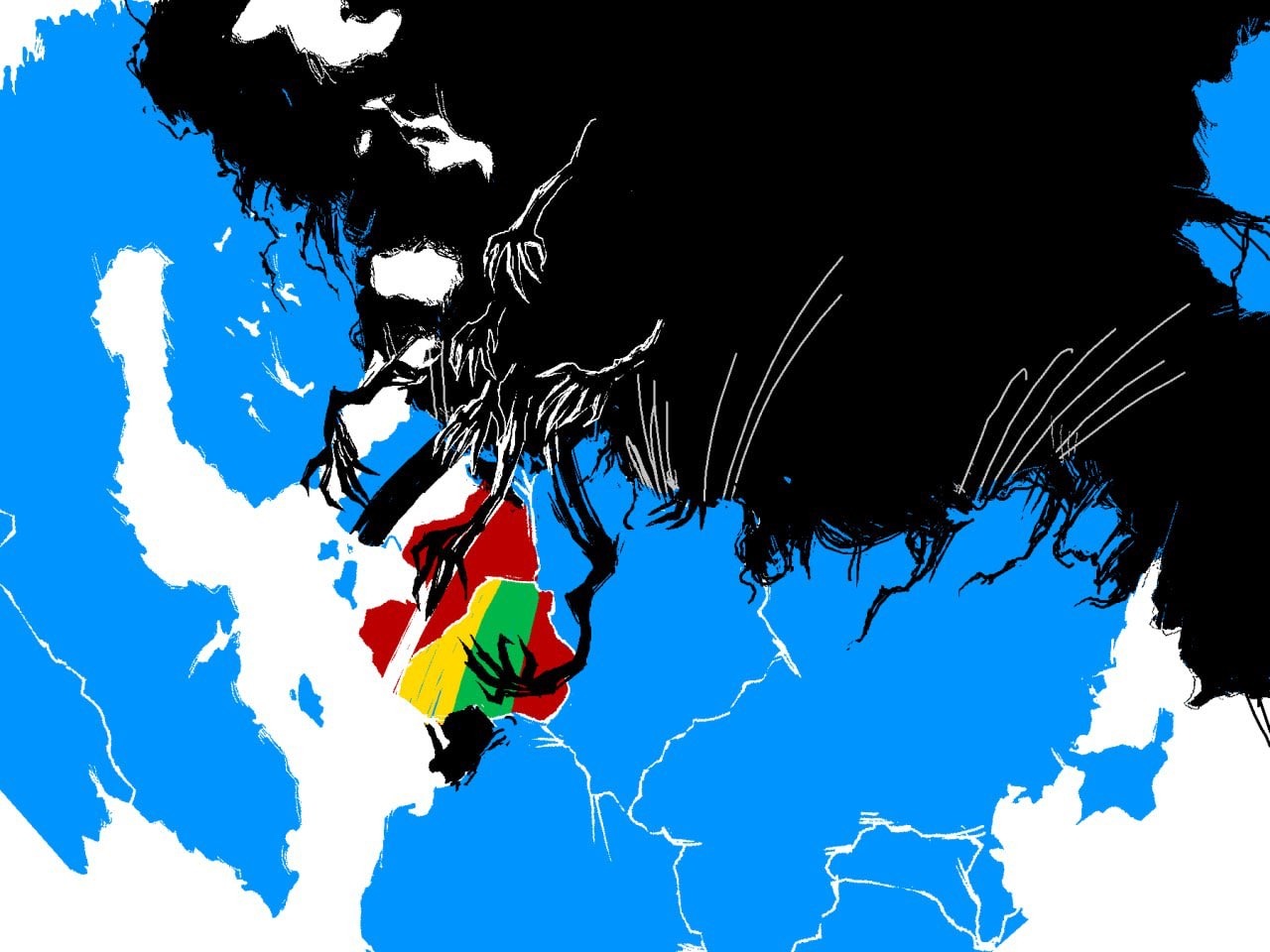
Source: Dossier Center
We presented Russia’s strategic interests documents to the Baltic prime ministers and asked them for their comments.
Kaja Kallas, Prime Minister of Estonia
Estonia [and] our allies and partners have long been aware of Russia’s interest to use hybrid tactics to pursue their goals and try to assert their influence in other countries. It’s Russia’s classic playbook, many of their tactics are taken straight from the KGB.
It is no surprise that the Kremlin seeks to attack democracies by trying to undermine the integrity of elections, weaponise corruption, spread disinformation and erode unity between Allies. One of Russia’s long-term goals is to expand and strengthen its own grip on power by influencing the decisions of our governments and within our societies.
The most important thing is to be aware and prepared. This year there are elections in quite a few democracies so countries must be extra vigilant against any potential threats.
We know our neighbor. Our job is to continuously share our knowledge of Russia’s actions, build resilience and stand against Russia’s direct and indirect attempts of influence. We have had to bolster our defenses to stand up against any threat, including hybrid threats. And it’s also crucial to discuss these matters publicly.
Krišjānis Kariņš, Prime Minister of Latvia
Latvia has been facing Russia’s desire to strengthen and expand its influence in neighboring countries since the restoration of independence. Latvia maintains a realistic view of Russia’s foreign policy and its initiatives. In recent years, especially after February 24, 2022, when Russia launched a full-scale invasion of Ukraine, we have been purposefully reducing the presence of Russia’s and its allied interests in Latvia, our economic and informational space, to reduce the chances of our Eastern neighbor influencing Latvia’s chosen political course. At the international level, Latvia actively advocates for and promotes Russia’s isolation. Latvia’s geopolitical orientation is towards democratic partners: EU, NATO, and OECD member states.
Ingrida Šimonytė, Prime Minister of Lithuania
I would say that measures that are mentioned or the goals, the spheres of influence that are mentioned, are not surprising. Definitely energy and societal issues like ethnic minorities, their rights—this is something you would usually suspect Russia to include into their plans for the Baltic states. But given that [the] invasion into Ukraine has changed everything, I think this is very much irrelevant. Given that—in terms of energy independence, security—[the] Baltic countries are doing at most to be self-sustainable as soon as possible and the electricity grid is the only part that is still not there, but there are no commercial flows, just the technical situation that we try to sort out sooner.
 The text was written as part of an international collaboration
The text was written as part of an international collaboration
of VSquare and FRONTSTORY.PL with:
Delfi Estonia,
Expressen,
Kiyv Independent,
Yahoo News,
Süddeutsche Zeitung,
Westdeutscher Rundfunk (WDR),
Dossier Center,
NDR (Norddeutscher Rundfunk),
Re:Baltica,
LRT
Head of the investigative desk at Delfi Estonia, Holger Roonemaa has extensively investigated topics related to national security, including Russia’s espionage, interference, and influence operations in Estonia and the wider region. He is a member of the International Consortium on Investigative Journalists (ICIJ). Estonia’s national media association named him the journalist of the year in 2020 and 2021.

